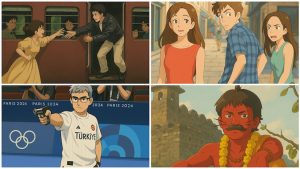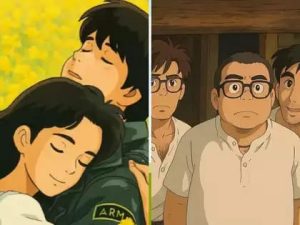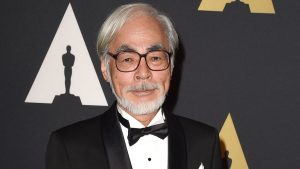Studio Ghibli’s Iconic Animation Style Meets AI-Generated Art
Studio Ghibli, Japan’s legendary animation studio, has captivated audiences for decades with its hand-drawn, detail-rich animation style. Recently, artificial intelligence has sparked a viral trend by replicating the studio’s signature aesthetic. OpenAI’s latest image-generation technology has allowed users to create “Ghibli-style” images, transforming everyday photos into illustrations that resemble the magical worlds of Spirited Away, My Neighbor Totoro, and Howl’s Moving Castle.
While these AI-generated artworks have delighted social media users, they have also raised ethical and legal concerns. Studio Ghibli’s co-founder, Hayao Miyazaki, has long been vocal about his disdain for AI-generated animation, calling it an “insult to life itself.” As the trend gains momentum, questions about artistic integrity, copyright, and the role of AI in creative fields continue to grow.

What Is Ghibli?
Founded in 1985 by Hayao Miyazaki, Isao Takahata, and producer Toshio Suzuki, Studio Ghibli is one of the most respected animation studios in the world. Known for its breathtakingly detailed, hand-drawn films, the studio has produced some of the most beloved animated classics, including:
- My Neighbor Totoro (1988)
- Kiki’s Delivery Service (1989)
- Princess Mononoke (1997)
- Spirited Away (2001) – Winner of the Academy Award for Best Animated Feature
- Howl’s Moving Castle (2004)
- The Wind Rises (2013)
The name “Ghibli” comes from an Italian word for a hot desert wind, symbolizing Miyazaki’s vision of bringing a fresh breeze to the animation industry.
The Magic of Ghibli’s Animation Style


What sets Studio Ghibli apart from other animation studios is its distinct artistic style. Unlike modern computer-generated animation, Ghibli films are known for their:
- Hand-drawn Animation: Every frame is meticulously illustrated, with each movement carefully crafted by animators.
- Soft Pastel and Muted Colors: The studio avoids overly bright or saturated hues, creating a natural, dreamlike aesthetic.
- Detailed Backgrounds: Ghibli films feature breathtaking landscapes, whether it’s the lush forests in Princess Mononoke or the floating cities in Laputa: Castle in the Sky.
- Expressive Characters: The emotions of Ghibli characters are depicted with stunning realism, bringing them to life without relying on exaggerated expressions.
One of the most impressive aspects of Studio Ghibli’s animation is its attention to detail. In The Wind Rises, for example, every frame was hand-drawn and painted with watercolors. A single scene, depicting a bustling marketplace, reportedly took over a year to complete.
AI-Generated Ghibli-Style Images Take Over the Internet
With OpenAI’s latest image-generation feature, users can now create illustrations in the style of Studio Ghibli within seconds. This has led to an explosion of AI-generated content on social media platforms, with people “Ghiblifying” their daily lives—turning photos of city streets, cozy cafes, and personal portraits into animated scenes that resemble Miyazaki’s world.
However, this viral trend has sparked controversy among artists and animators. Many believe that AI-generated images devalue the painstaking work that goes into traditional animation.
Hayao Miyazaki’s Strong Opposition to AI Art


Miyazaki has never been a fan of artificial intelligence in creative industries. In a 2016 documentary, NHK Special: Hayao Miyazaki — The One Who Never Ends, he reacted to an AI-generated animation demonstration with strong disapproval.
“I am utterly disgusted,” he said. “If you really want to make creepy stuff, you can go ahead and do it. I would never wish to incorporate this technology into my work at all. I strongly feel this is an insult to life itself.”
His words reflect a deep concern for the future of art and creativity. Unlike AI-generated images, which rely on pre-existing data to mimic styles, Ghibli’s work is driven by human emotions, experiences, and craftsmanship.
Ethical and Legal Concerns Over AI-Generated Ghibli Art
The rise of AI-generated art raises critical ethical and legal questions. While AI can replicate Ghibli’s aesthetic, should it?
Copyright and Intellectual Property Issues
Many argue that AI models trained on existing artworks without permission violate copyright laws. However, legally speaking, while specific works are protected, replicating a style is a grey area. This means that while Studio Ghibli owns the rights to its films, it may not have legal grounds to prevent AI from mimicking its artistic style.
The Impact on Human Artists
Many illustrators fear that AI-generated content could devalue human artistry. If AI can create high-quality illustrations in seconds, it could threaten job opportunities for traditional animators and digital artists.
Zelda Williams, daughter of the late actor Robin Williams, voiced her concerns over AI art replacing human creativity. “The soul of art lies in the hands of its creators, not in an algorithm,” she stated.
The Future of AI in Animation
While AI-generated images have proven to be a fascinating technological development, they also pose important questions about the future of creativity.
- Will AI replace human animators? Experts believe that while AI may assist in animation production, it cannot replicate the heart and soul of a film like Studio Ghibli’s.
- Should AI-generated art be regulated? Many artists advocate for clearer guidelines on AI usage in creative industries.
- Can AI and traditional art coexist? Some believe AI can be used as a tool rather than a replacement, helping artists generate ideas while preserving hand-drawn animation techniques.
Despite these discussions, one thing is certain—Studio Ghibli’s timeless animation style will continue to inspire generations, whether through human hands or, controversially, through AI-generated creations.
Also Read : Kannappa Release Postponed: Vishnu Manchu Reveals Reason for Delay
The viral trend of AI-generated Studio Ghibli-style images has reignited discussions on the intersection of art, technology, and ethics. While fans appreciate the nostalgic aesthetic of Ghibli-inspired AI illustrations, many argue that such creations lack the emotional depth and painstaking craftsmanship that define Miyazaki’s work.
As AI continues to advance, it is crucial to consider how it impacts traditional artistic fields. Whether embraced or rejected, one thing remains clear—Studio Ghibli’s legacy will always be a testament to the power of human creativity.

